Welcome to the released version of TimeTrak 19.1.
We have changed our versioning to be in line with the year of the release to be more familiar for clients.
In this version, we have some exciting new features and settings, also a new, fresher look of TimeTrak.
Improved Timeline and Group Scheduling Features
The biggest change in 19.1 is to how work can be scheduled.
Instead of our usual method of scheduling a job or task against resources (users and equipment), there is now the added ability to schedule resources against jobs/ tasks in a queue.
Items in the queue can now be displayed in a calendar timeline view, with the timeline view also having added improvements.
Queues in calendar
A queue can now be set so that queue data (jobs/tasks) is listed on a timeline calendar view to provide the ability to schedule resources against the data in the specified queue.
Queues are configured in the TimeTrak Administrator Console and can be populated automatically by a SQL statement or managed manually by users adding items to them.
For more information on Queues click here.
In the below example, the queue “In Progress” will be used to list jobs on a timeline calendar view.
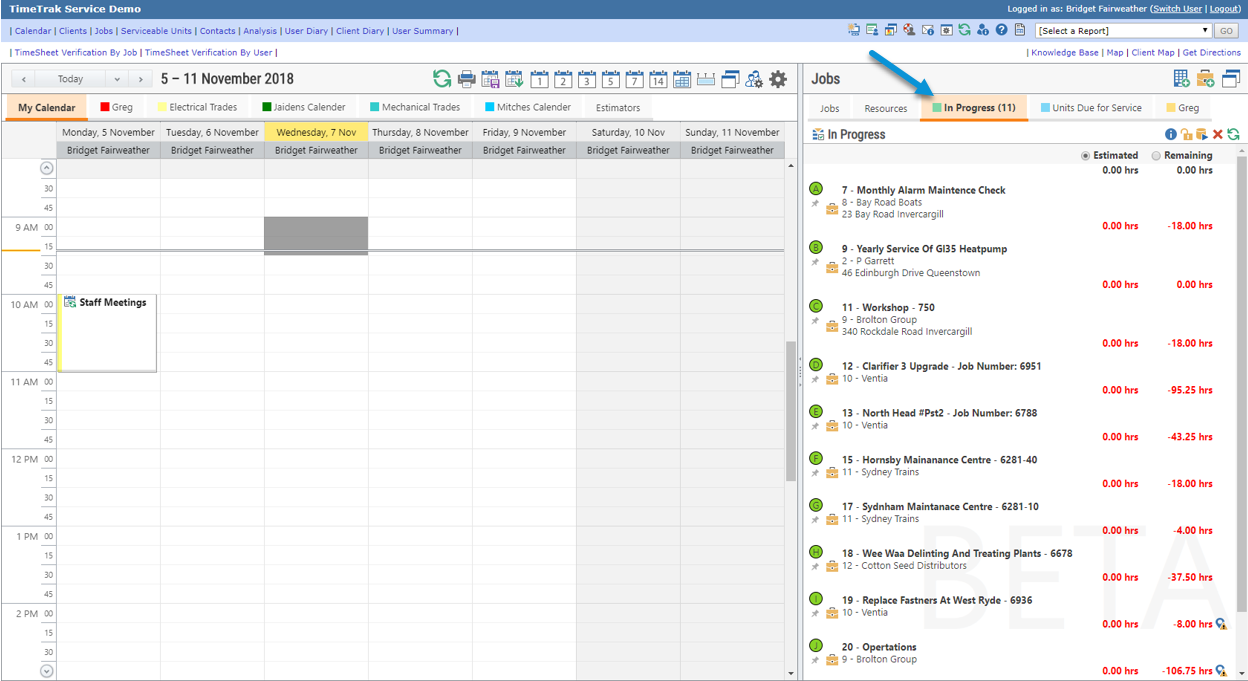
In Professional, within the Manage WorkGroups settings, set the queue as a workgroup view in calendar.
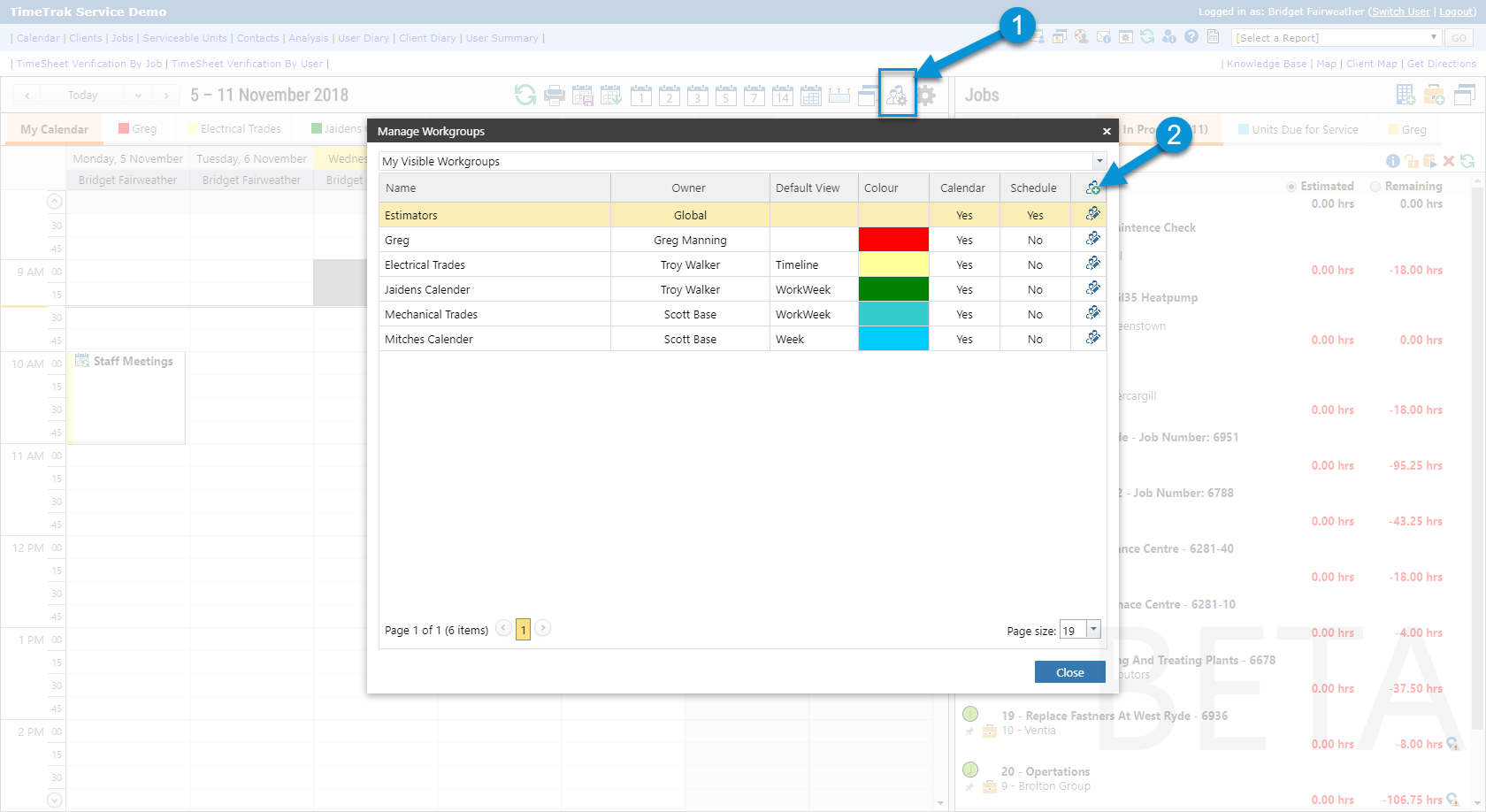
Upon adding a new WorkGroup queue the Calendar Resource must be set to “Queues”, Schedule View set to “Timeline View”.
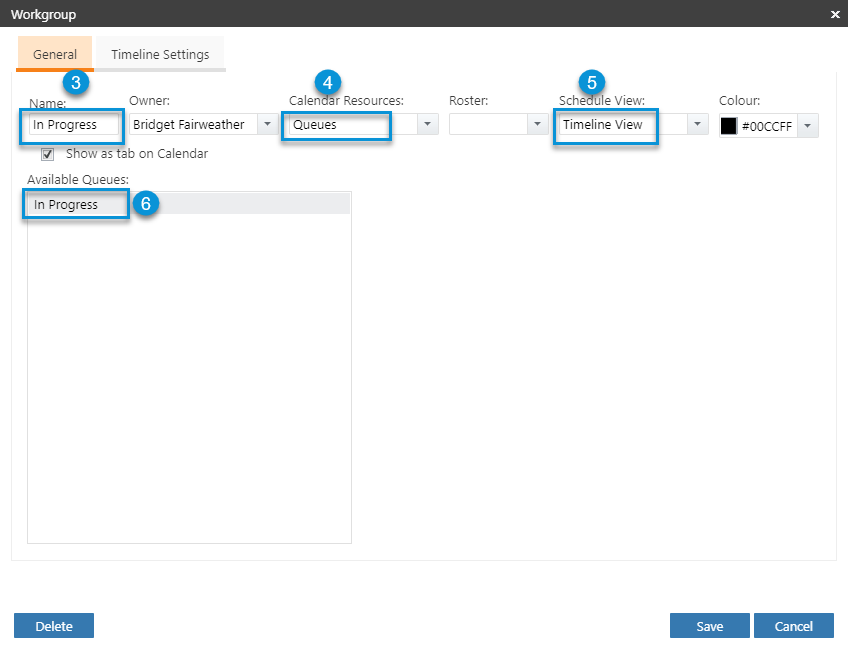
This will now display the list of jobs, within the queue, on the calendar.
- WorkGroup Queue
- Timeline View
- Calendar Display
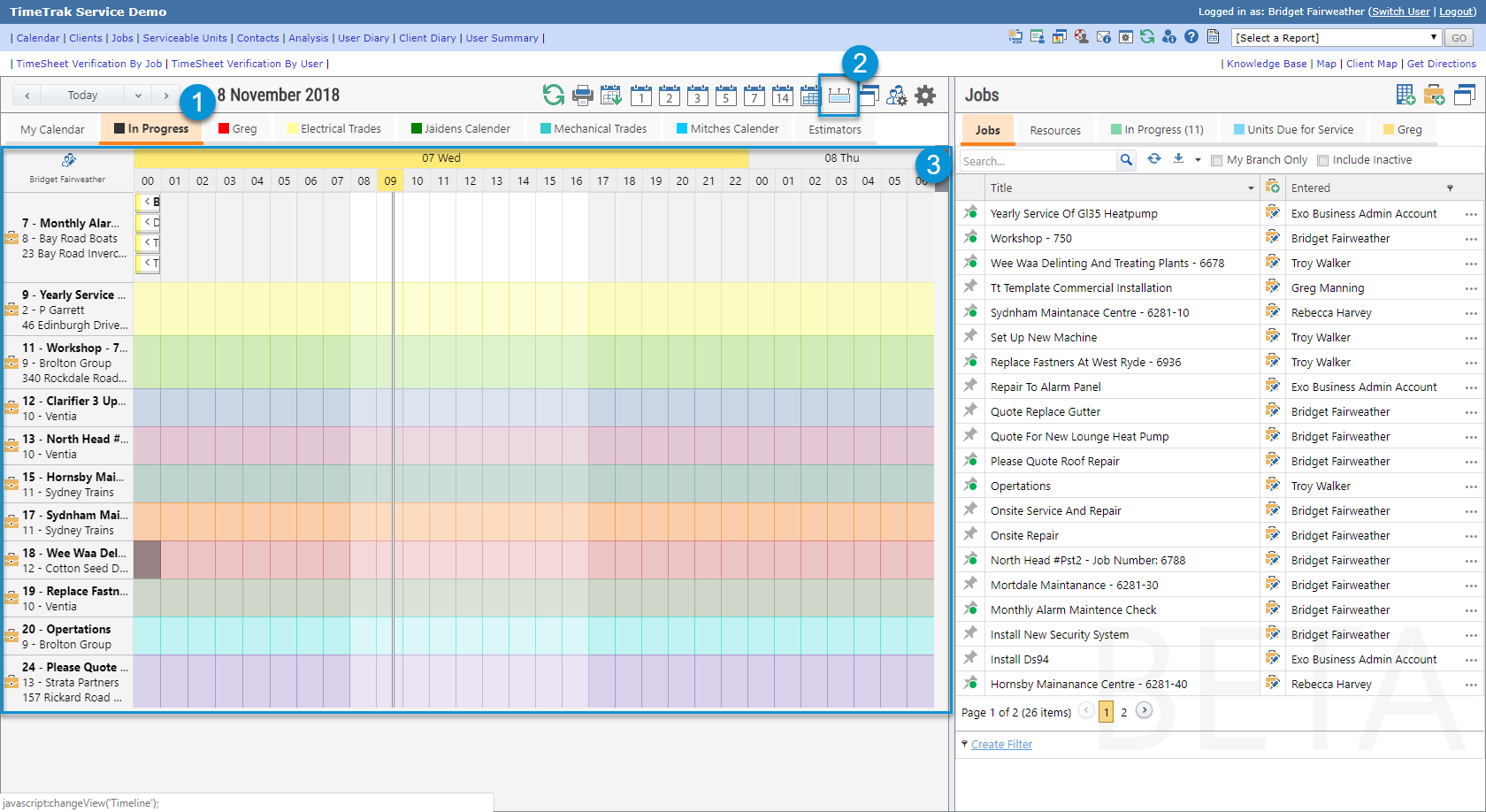
To complement this feature, there is the ability to enable a resource tab which provides users the ability to quickly add resources onto the job.
To enable the resource tab as per below:
- Calendar Settings
- Resource Tab
- Enable “Show Resource Tab”
- Save
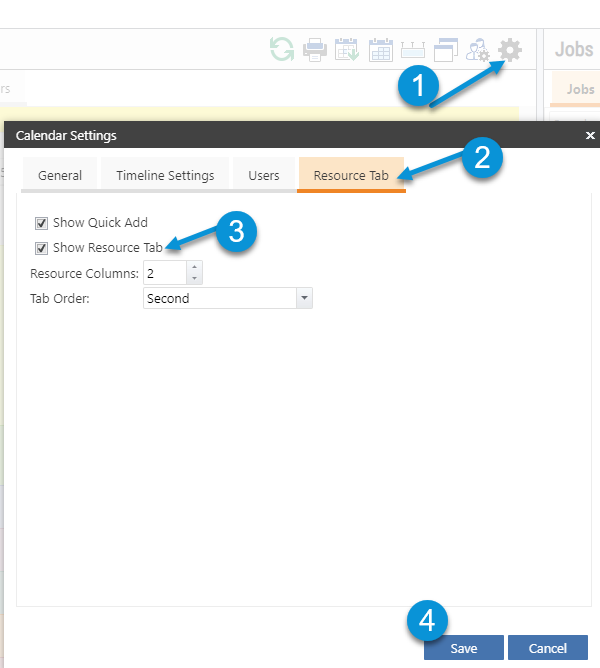
- If “Show Quick Add” is enabled, users can create appointments quickly without the appointment screen loading (appointment defaults will be passed into the appointment).
- Resource Columns defines how may columns of users are displayed in the resource panel.
- Tab Order defines where in resource panel sits in your job/task/queue tabs.
If resources are already scheduled at the time selected, this is displays as a red icon against the resource and means the resource is not available during that allocated time.

Hide/Show Empty Calendar Resources
This allows schedulers to review jobs that only have appointments against them.
In this example, there is a list of jobs but only three of these jobs have been scheduled or have a time entry against them.
By right clicking on the workgroup and selecting “Hide Empty Calendar Resources” as per below:
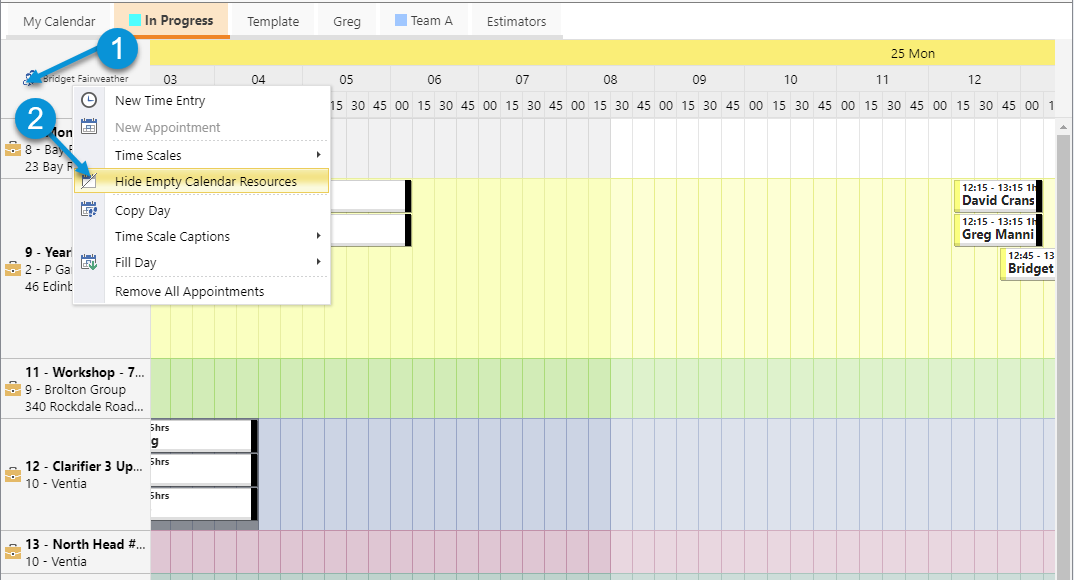
Only the jobs that have appointments or time entries against them now display.
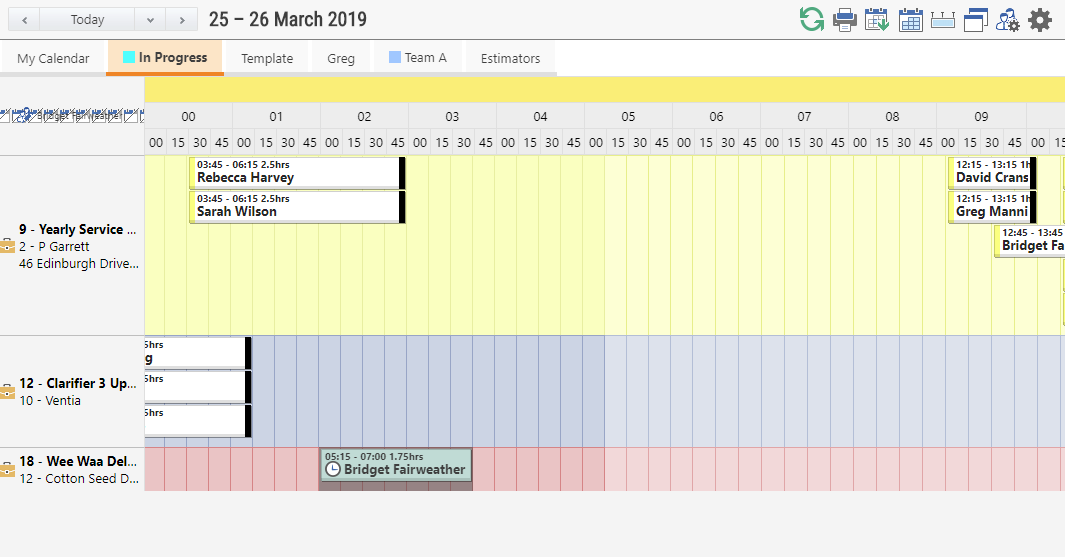
To get all the jobs in the queue to display again, right click on the work group and select “Show Empty Calendar Resources”.
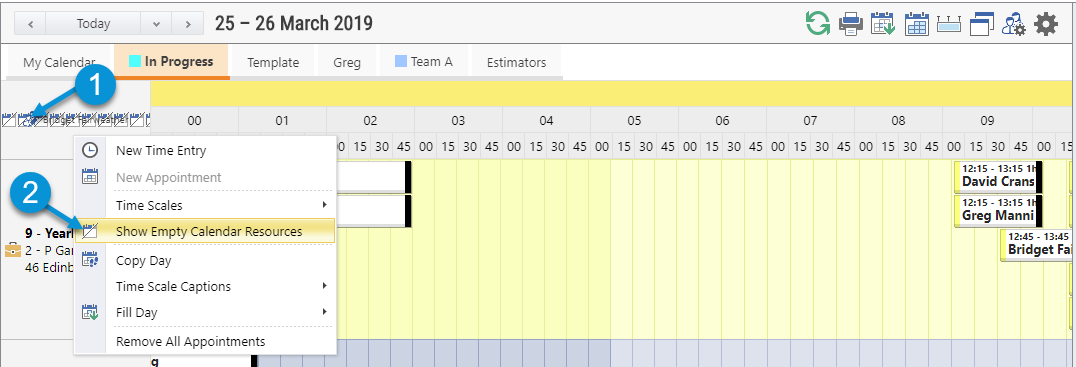
As an addition to the above Timeline enhancements, a side scroll has been added on the calendar Timeline View to improve navigation especially on use of a queue calendar.
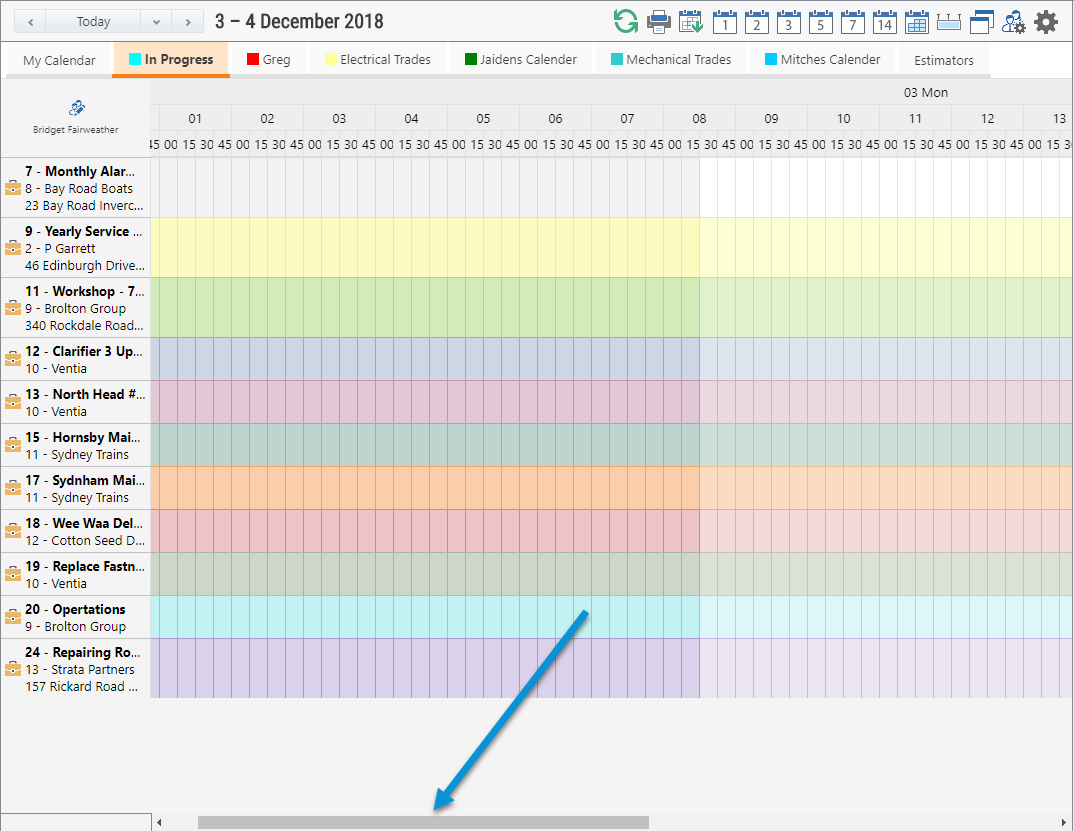
This is enabled by clicking the workgroup on the upper left corner of the calendar as per below.

Select the Timeline Settings tab and change the column count. This will increase the columns of your calendar and force it to enable the side scroll function.
Note: The maximum column count is 100.
Visible Columns is the amount of columns to display on screen without the need to scroll.
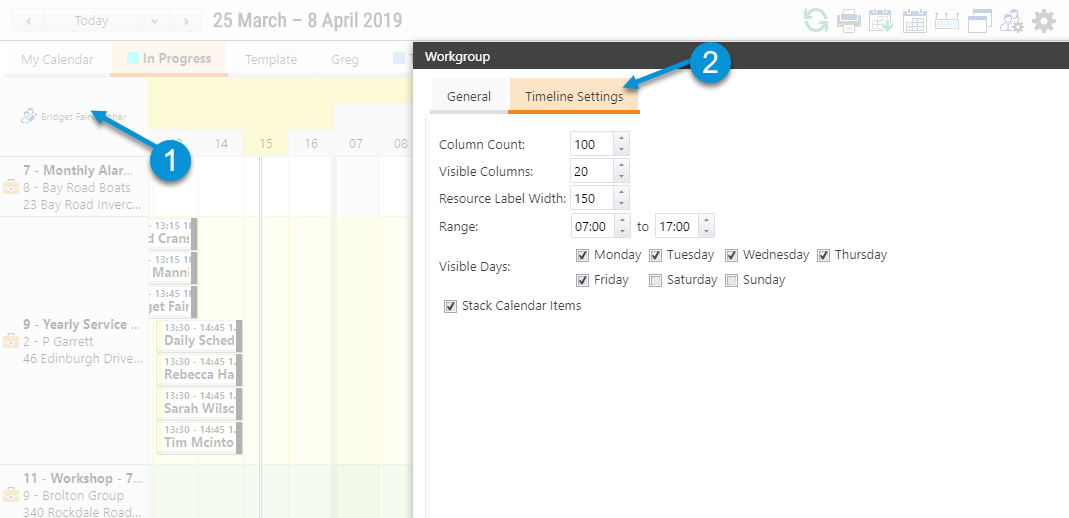
Stack Calendar Items
Continuing with our enhancements to our timeline view, there is an additional setting per timeline workgroup “Stack Calendar Items”.
This setting is to assist with the view of data in timeline views.
To enable: Select the workgroup > Timeline Settings > Enable “Stack Calendar Items” as per below:
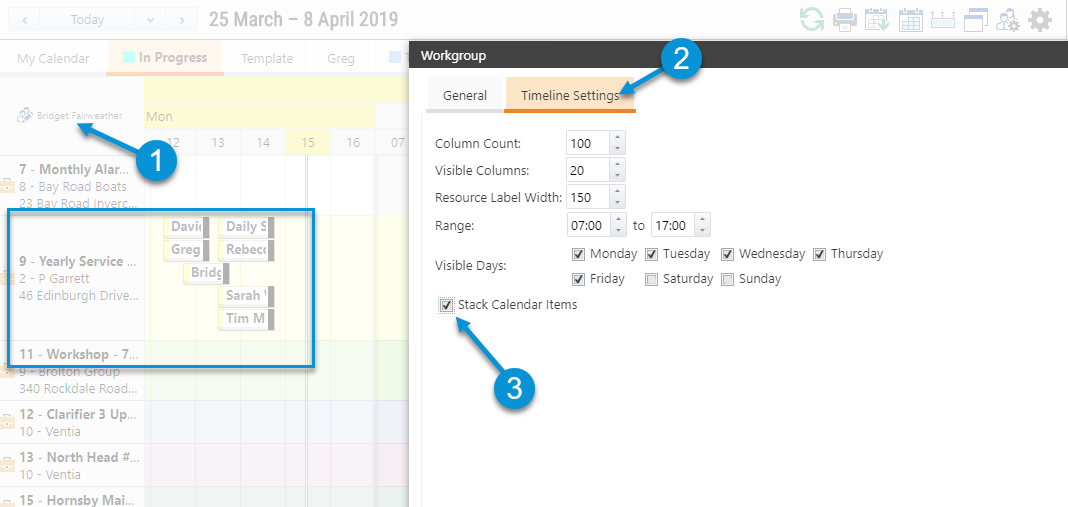
Once enabled, the display of data will be stacked-based and in many instances easier to read:
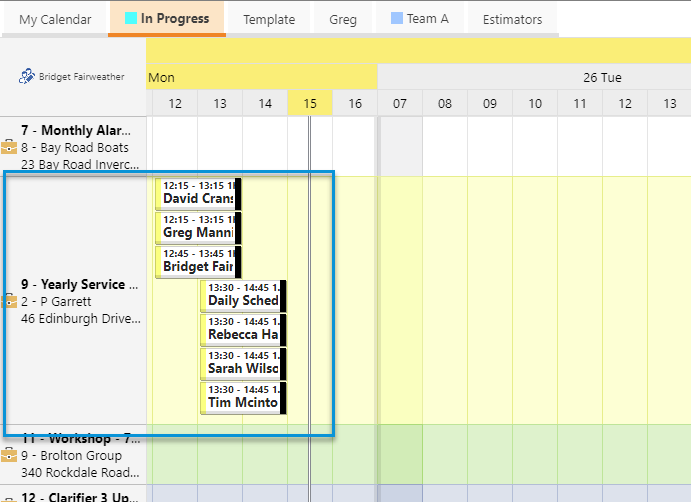
For more on Stacked Calendar Items, click here
Appointment Changes
In the TimeTrak Administrator Console, there are new colour option settings for appointments.
These can be set, as required.
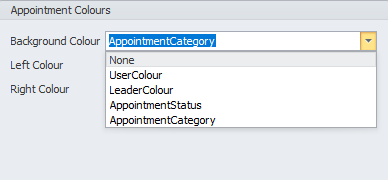
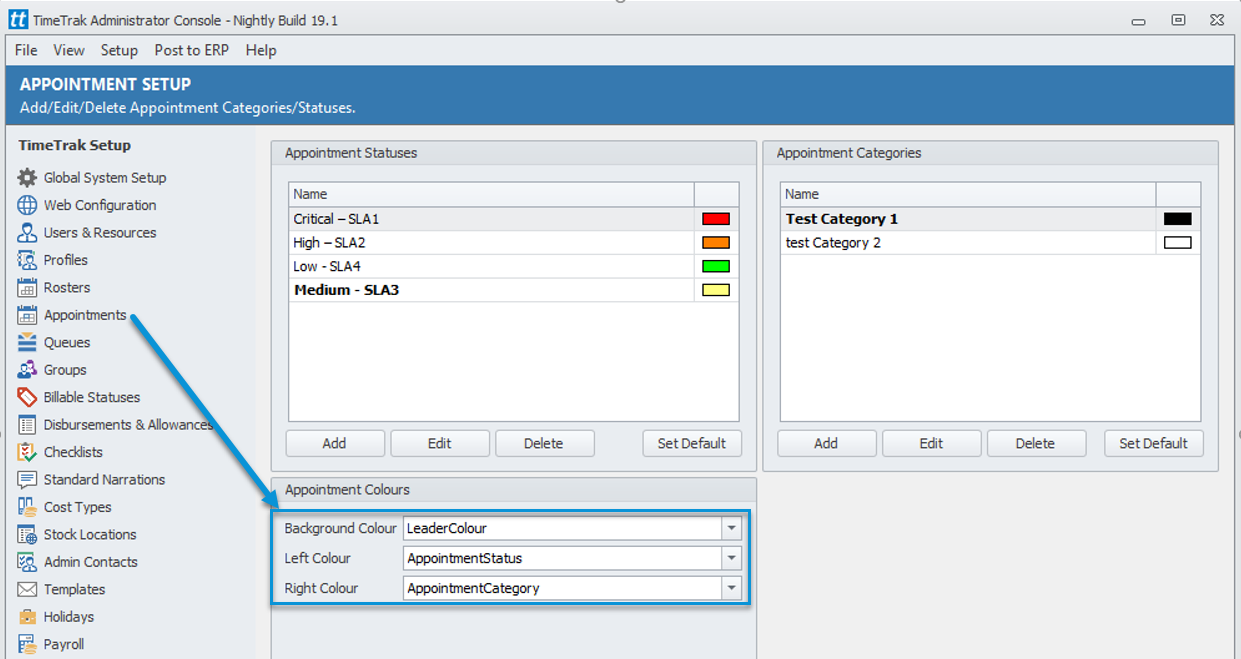
LeaderColour – Setting up the colour based on a leader assists visually on the calendar to help identify which group is scheduled on the job especially if your business heavily dependent on appointments and group scheduling – refer to “Leader” section of this document.
Appointment Categories and Appointment Statuses colour indicators, used in conjunction with the LeaderColour, now display differently and have moved to show on either the left and right of the appointment on the calendar.

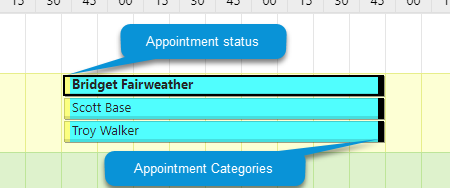
Leader
Version 19.1 introduces the ability for a leader of a group to be set at an appointment level, which as mentioned previously assists with group scheduling visually.
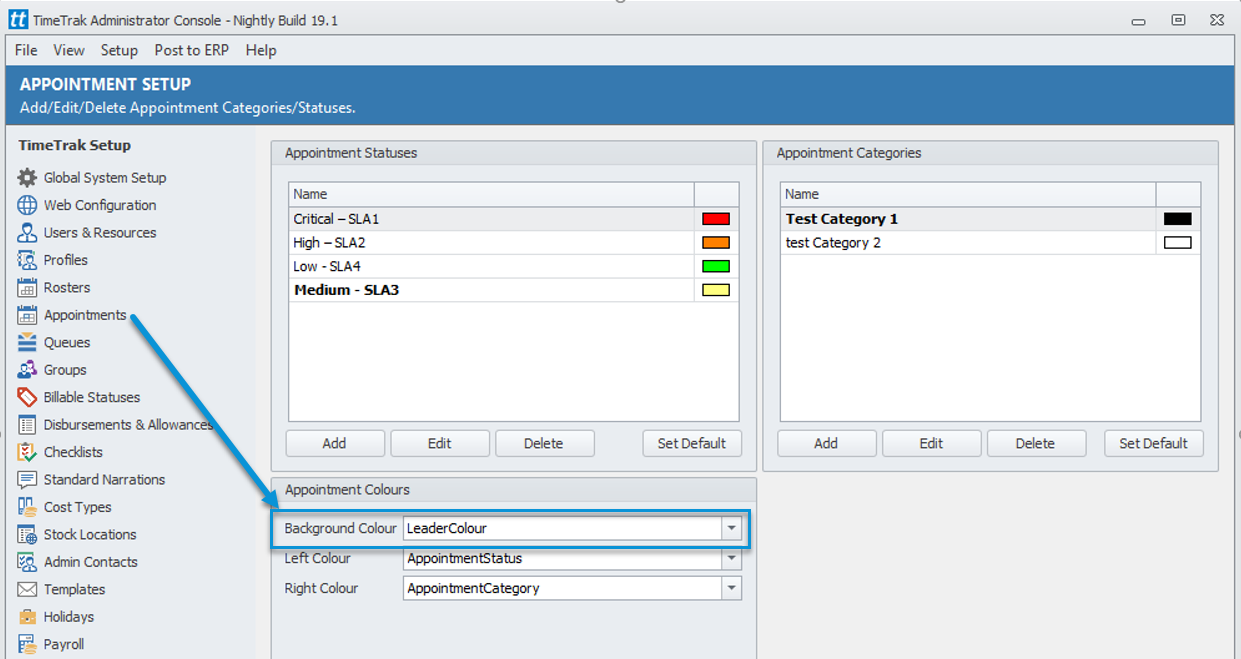
The Background Colour is set against the User Settings, if the user is set as the Leader then this colour will display.
Note: this will also group the other assigned resources with the same colour code as the leader.
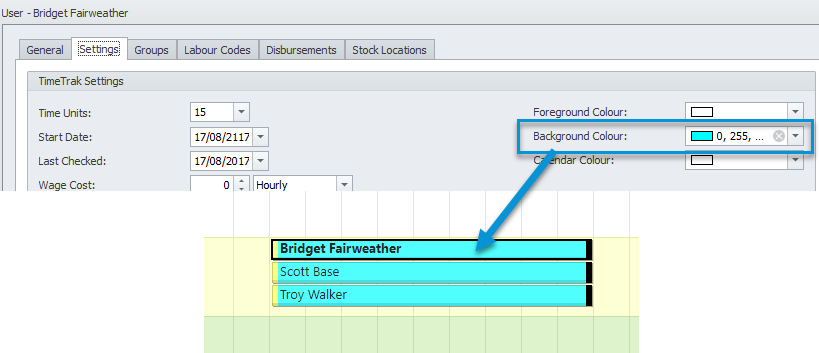
To assign a group leader, right click on the resource “Set Leader”.
Note: The name of the leader displays in bold font and the group is tagged with leader’s shortcode.

The Profile Shortcode and Profile Shortcode Colour are additional profile settings to complement the leader function.

Automatically create breaks when using fill day
There is now an additional setting at a profile level which is enabled by default, as per below.
However, when not enabled, if users do not have breaks setup when the “fill day” function is used on appointment creation, the appointment will not be split over the “default” 12pm break in TimeTrak allowing schedulers to see one appointment against a user instead of two which is more visually appealing in some screens.

Linked and Related Appointments
This feature brings an easier and more robust approach to scheduling groups of users.
Refer to this whitepaper for more information
Group Check In Behaviour
Due to the new “linked” and overlapping appointment function, there is now the below profile setting which stipulates the default group check-in behaviour.
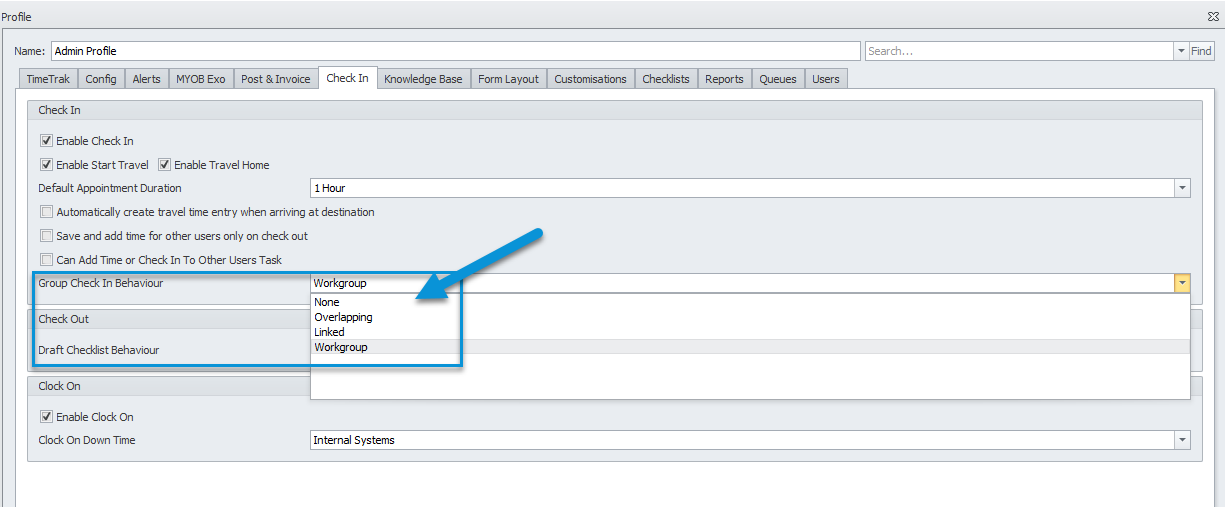
I.e.: If a Mobile user checks into an appointment do they check in all linked appointments, overlapping appointments, only those, which belong to their workgroup or none?
For more information, click here.
Mobile Calendar Range
In previous versions of TimeTrak, Mobile users were only able to see the current day’s events from their home screen.
There is now the below profile setting, which allows users to see up to seven days of their calendar from the TimeTrak Mobile home screen.
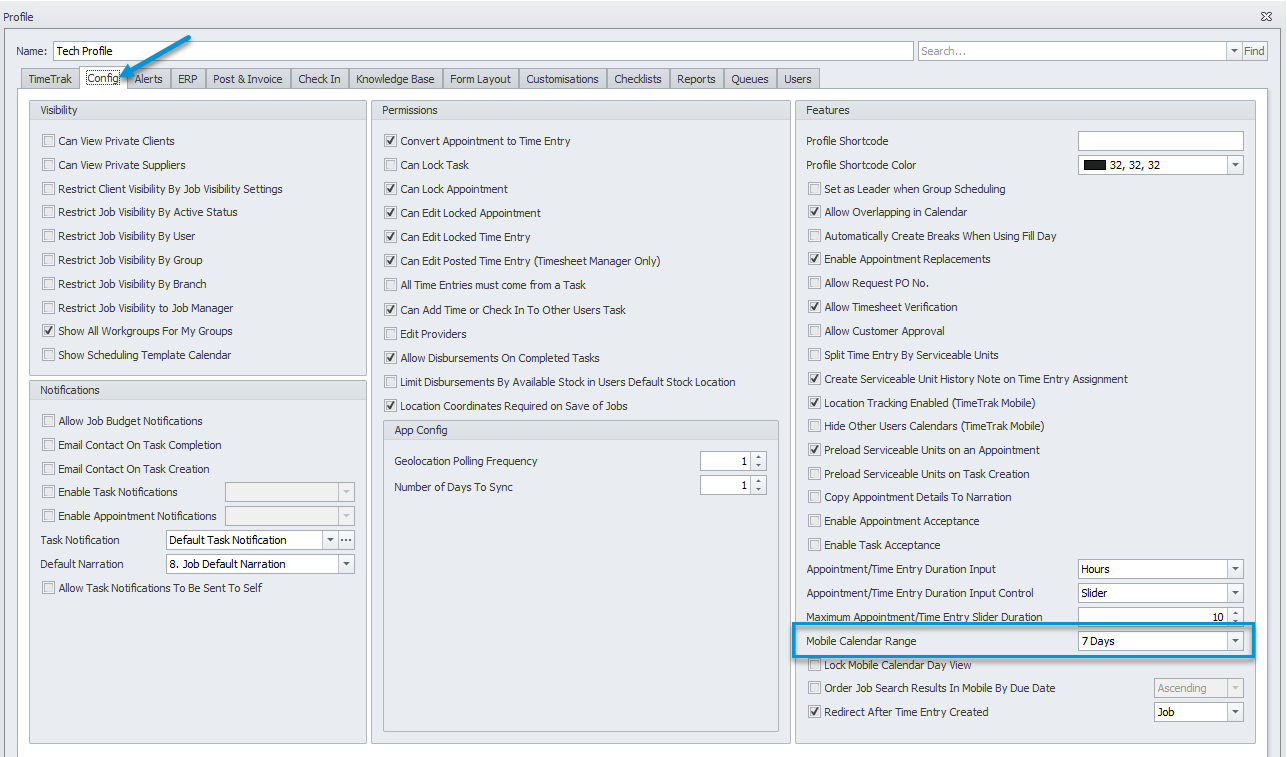
Once set against the users profile, if “Calendar” is enabled on their home screen they will see the calendar range specified by default.
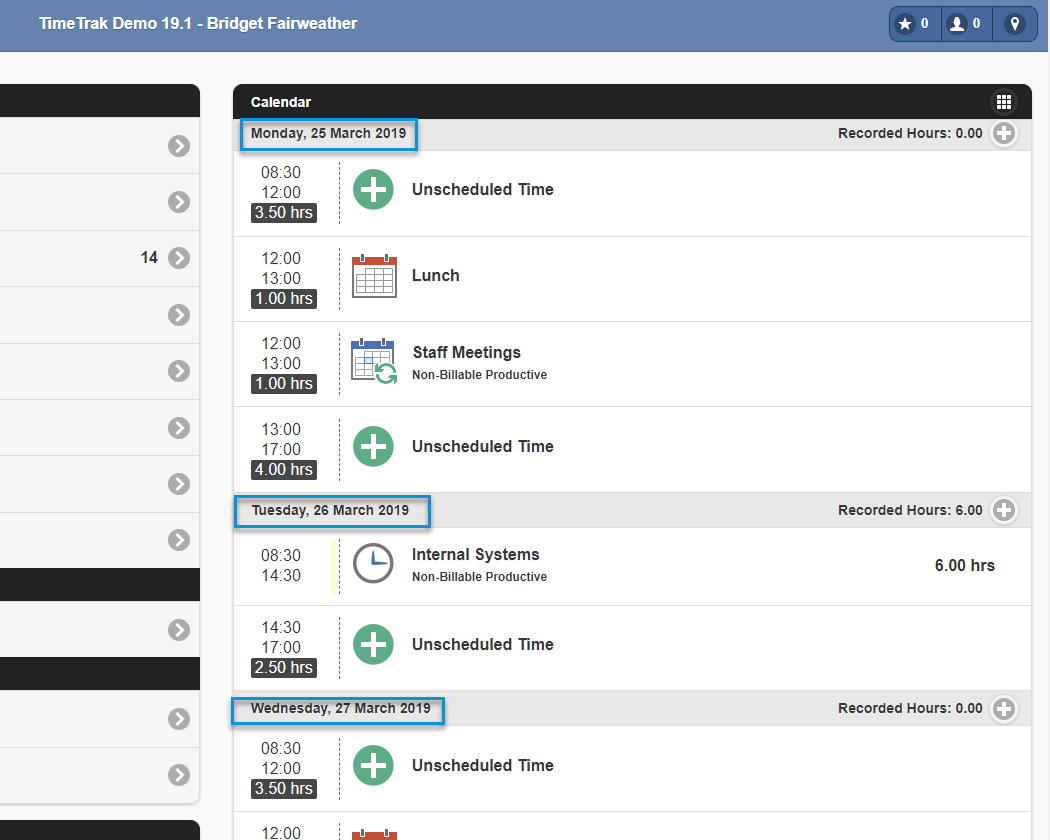
Lock Mobile Calendar View
There is now an additional profile setting so that the calendar view in Mobile can be locked down to a days view to prevent users seeing their future appointments.
For example: If a users profile has a Mobile calendar range of 24 Hours and “Lock Mobile Day View” is enabled as per below:
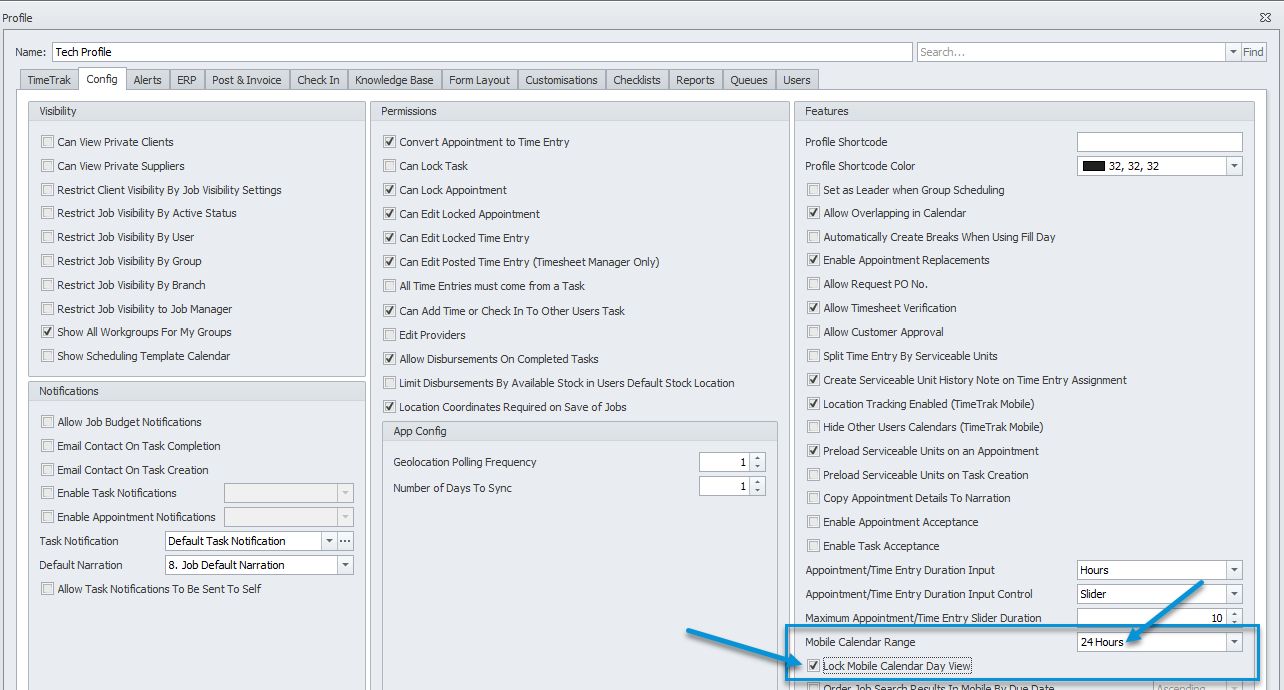
The users home screen in Mobile only displays one day and when going to the calendar they have no option to review past and previous days.
Scheduling Templates
This allows appointments to be assigned to a scheduling only calendar.
A scheduling only calendar is not user specific, however a user can check into appointments off that calendar.
This is useful where appointments need to be scheduled e.g. to a shift/run, but it’s unknown what users will be assigned to that shift/run until that day of work.
A Scheduling Template is its own user type, as per below, and has no licence cost or annual licence fee.
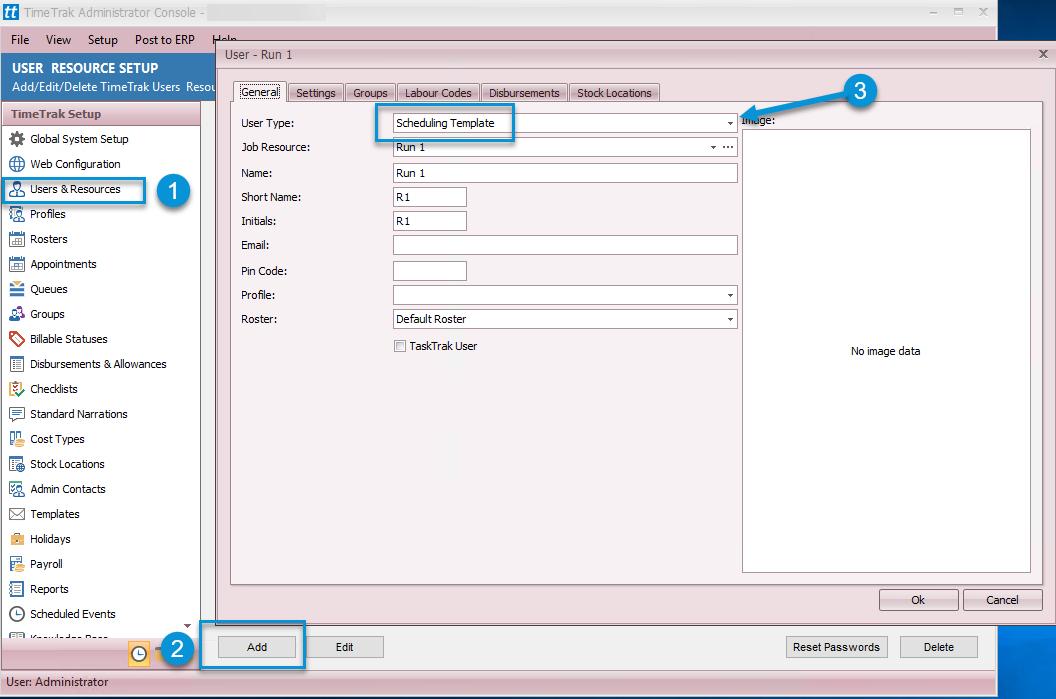
Show Scheduling Template Calendar
This setting operates in conjunction with the User Type option “Scheduling Template” and provides the ability for only certain profiles to have access to this schedule.

For more information on scheduling templates, click here.
Scheduled events
Scheduled events enables the ability to set a report to generate and email this automatically based on the scheduled date and time.
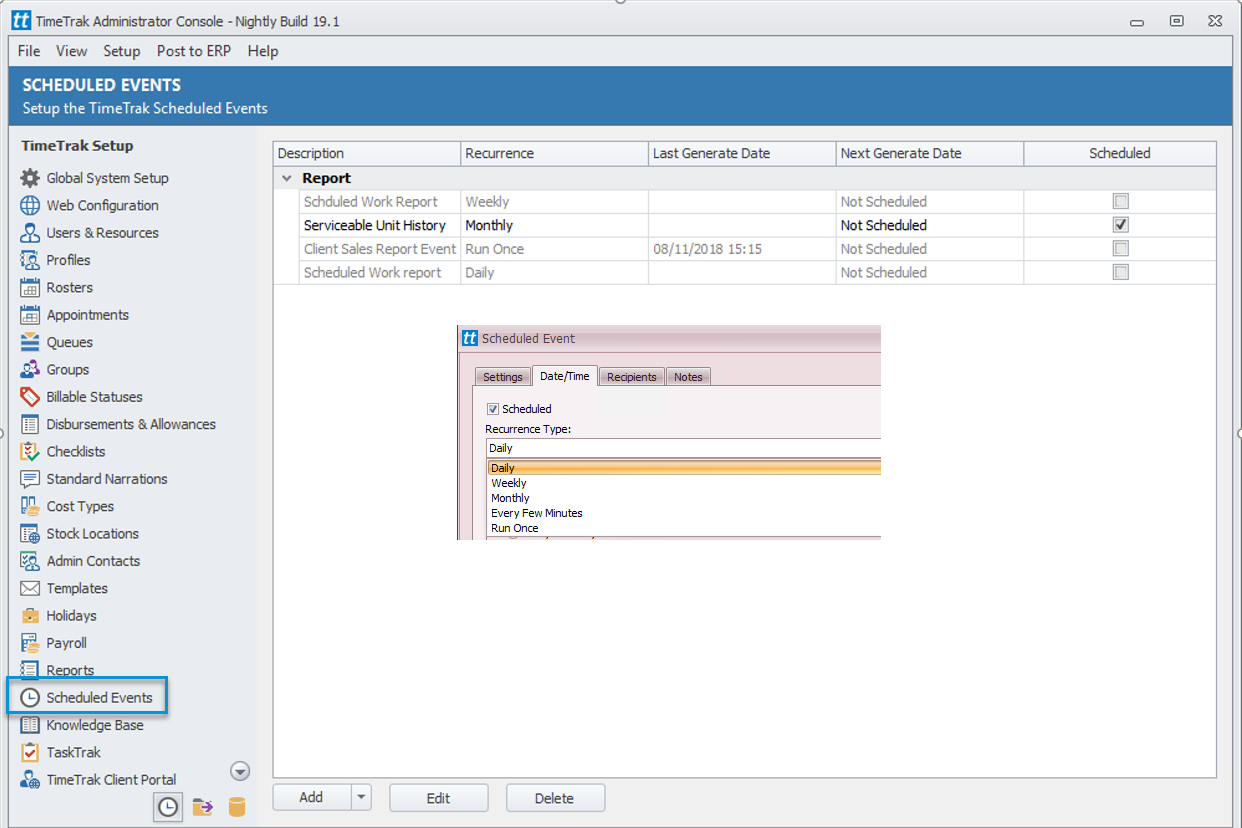
There is also the ability to customise the email that is sent with the report by adding a “Report Schedule Template”.
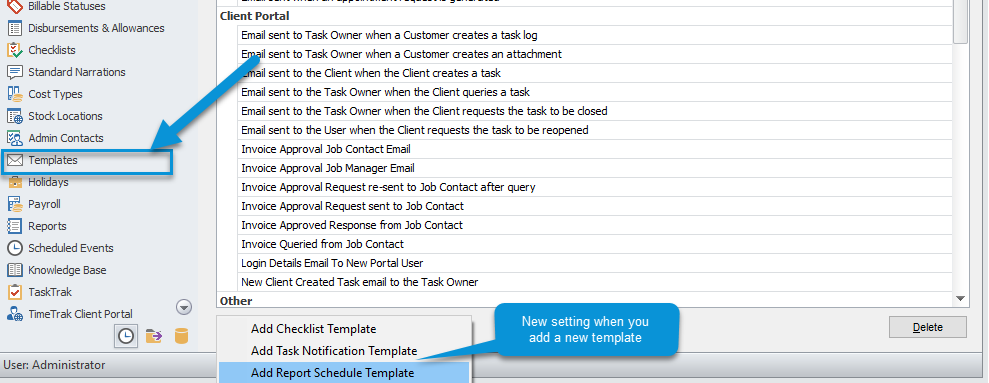
For more information on Scheduled Events, click here.
Mobile Workstation (PIN based login)
In an environment, such as a factory, where a group of users is operating from one area TimeTrak Mobile is the best setup.
However, in this instance, it is not practical that every user has their own device.
If there is a single workstation, TimeTrak Mobile now has the ability for multiple users to login to a shared workstation using pin codes.
This needs to be enabled at a database level as per below: Global System Setup > Admin Settings > Enable Pin Login in TimeTrak Mobile
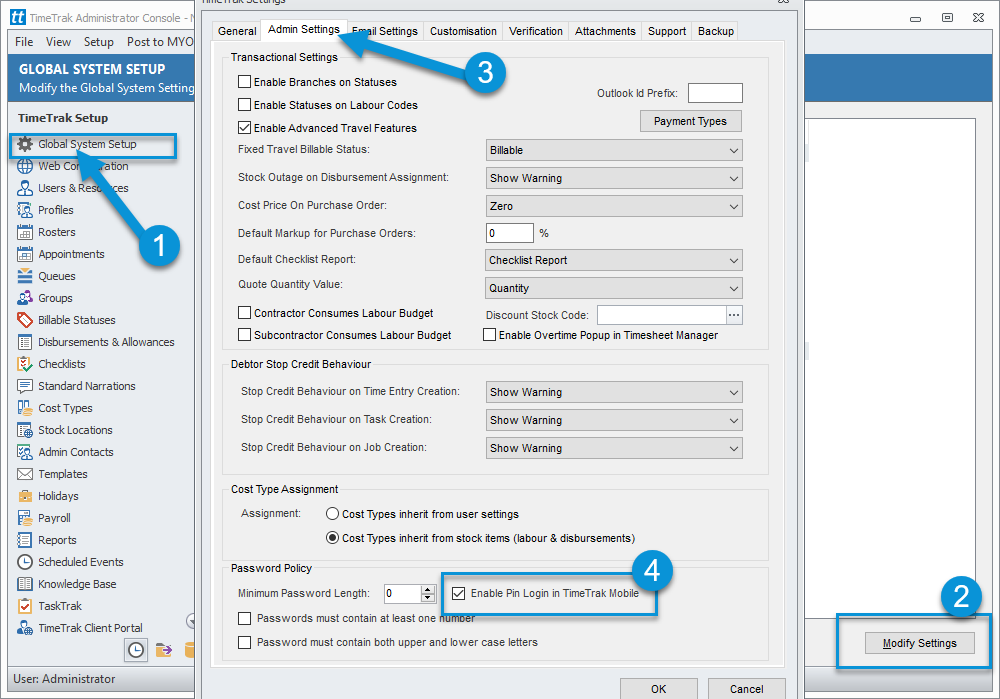
A Pin Code is then required to be set when creating and editing users, (these can also be managed from the user in the TimeTrak Admin Console like passwords).
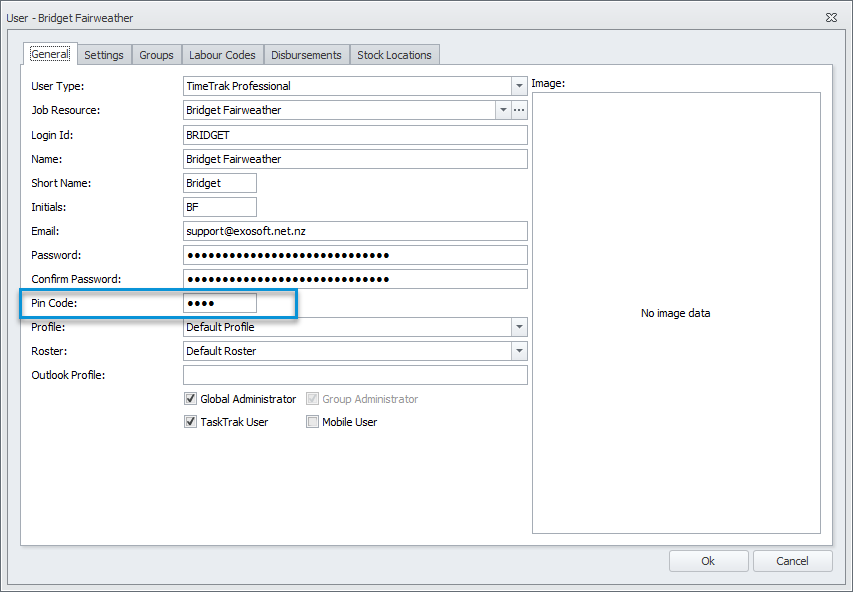
When users login to Mobile they will be prompted to set a PIN code.
TimeTrak Mobile will display a different login interface, as per below, allowing multiple users to access their TimeTrak Mobile configuration by simply entering their pin.
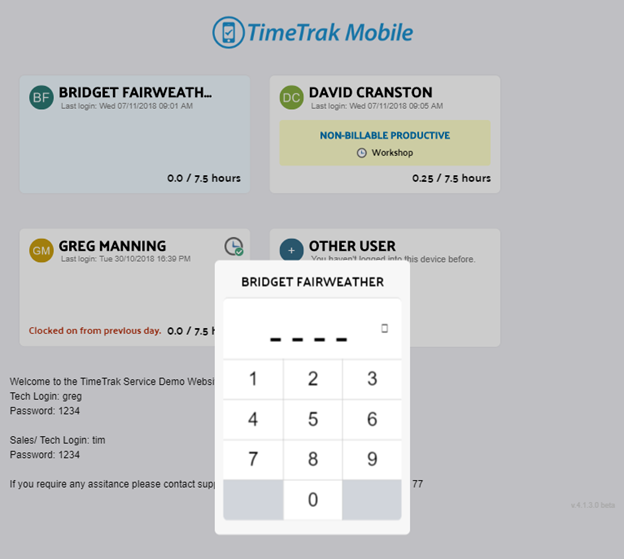
Automated Refresh of Test Environment
TimeTrak 19.1 has introduced the ability for end users to refresh their test TimeTrak environment without the assistance of a consultant.
Previously, refreshing a test TimeTrak environment was a very manual process which included manually backup and restoring databases, then configuring settings in the test once the database had been refreshed.
There is now a function within the TimeTrak Administrator Console which once configured by a TimeTrak Consultant allows end users to refresh their test environment by them self.
Note: Intervention will still be required for some clients who have inter-database customisations.
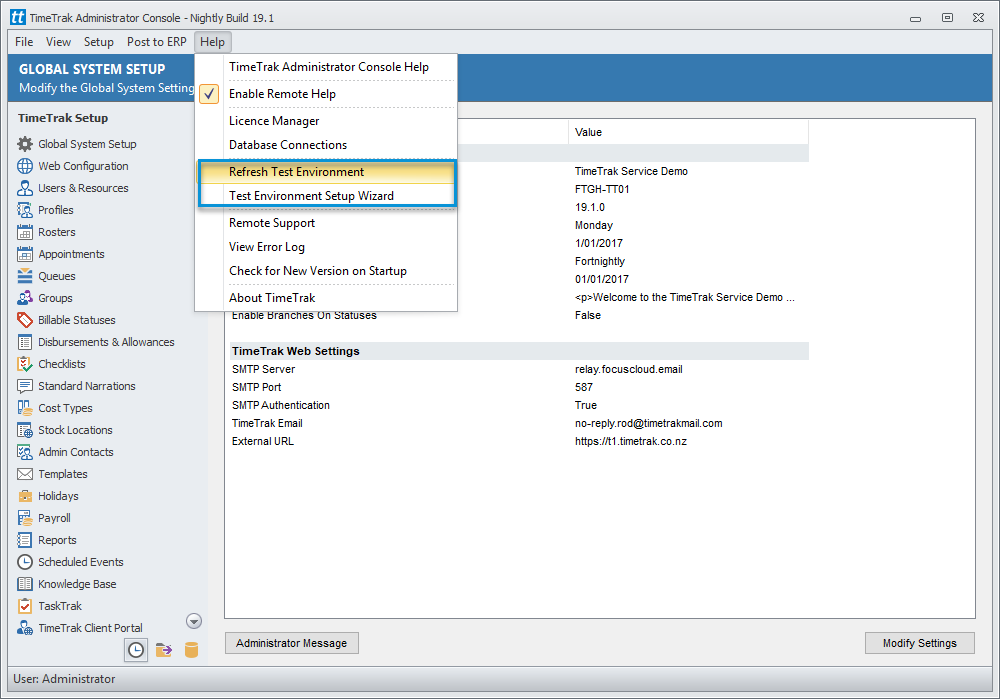
Improved Help and Searching in the Admin Console
A Search function has been added to the Administrator Console to assist lookup of specific settings without having to browse through every tab.

A brief functionality explanation of the setting will display by hovering the mouse over the item.
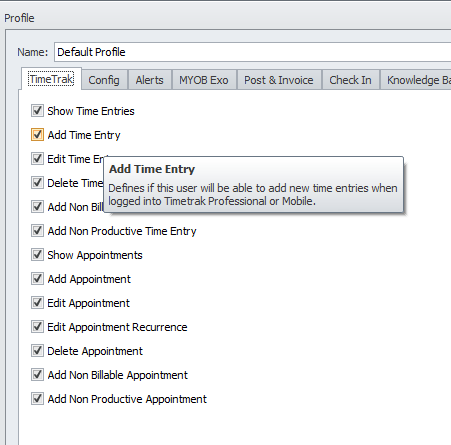
If the setting has high complexity and affects other settings, a pop-up help, along with the “whitepaper” or “tip of the week” link to our website, will display.
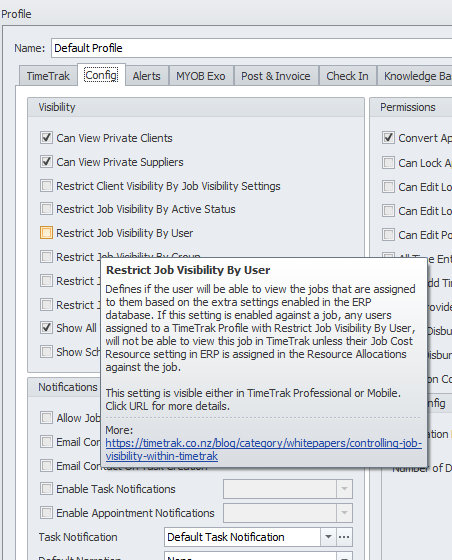
Follow Up Appointments
This is a new feature for Mobile users that want to create follow up appointments whilst onsite. On adding a time entry in Mobile, there is now a new option “Save & Add Appointment” as per below:
.png)
After selecting this option, users will be able to create a follow up appointment.
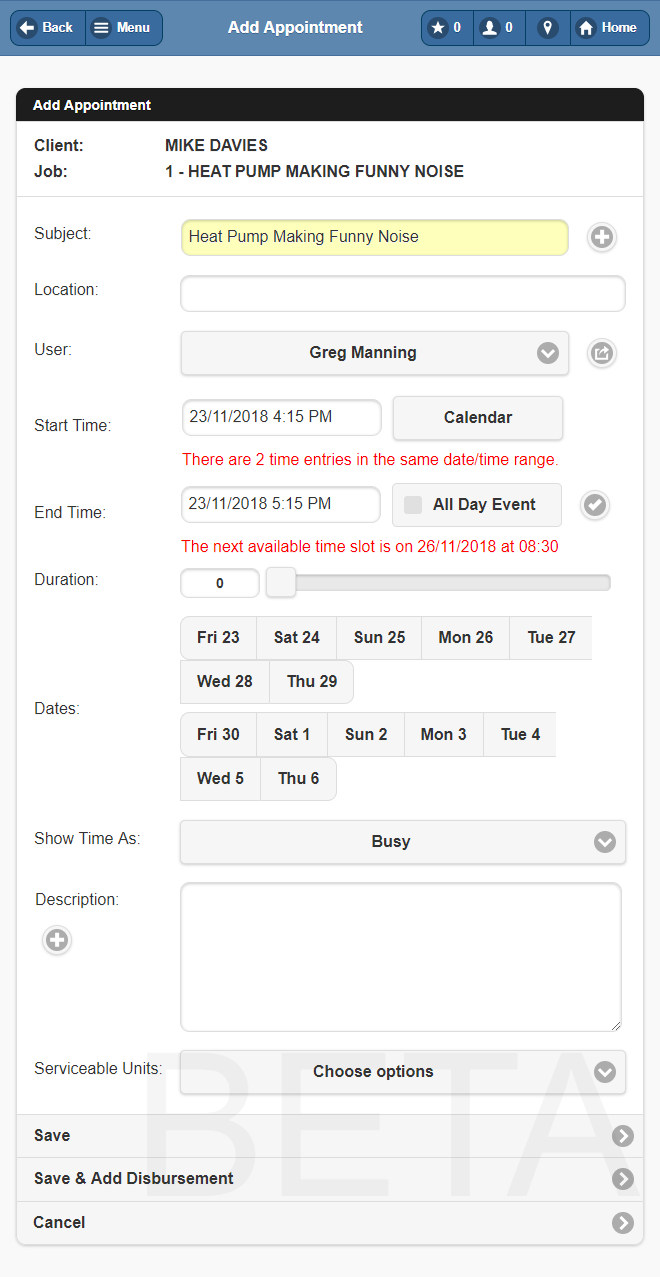
There is also the ability for users to select “calendar” within this screen so they can check their availability when booking the follow up appointment.
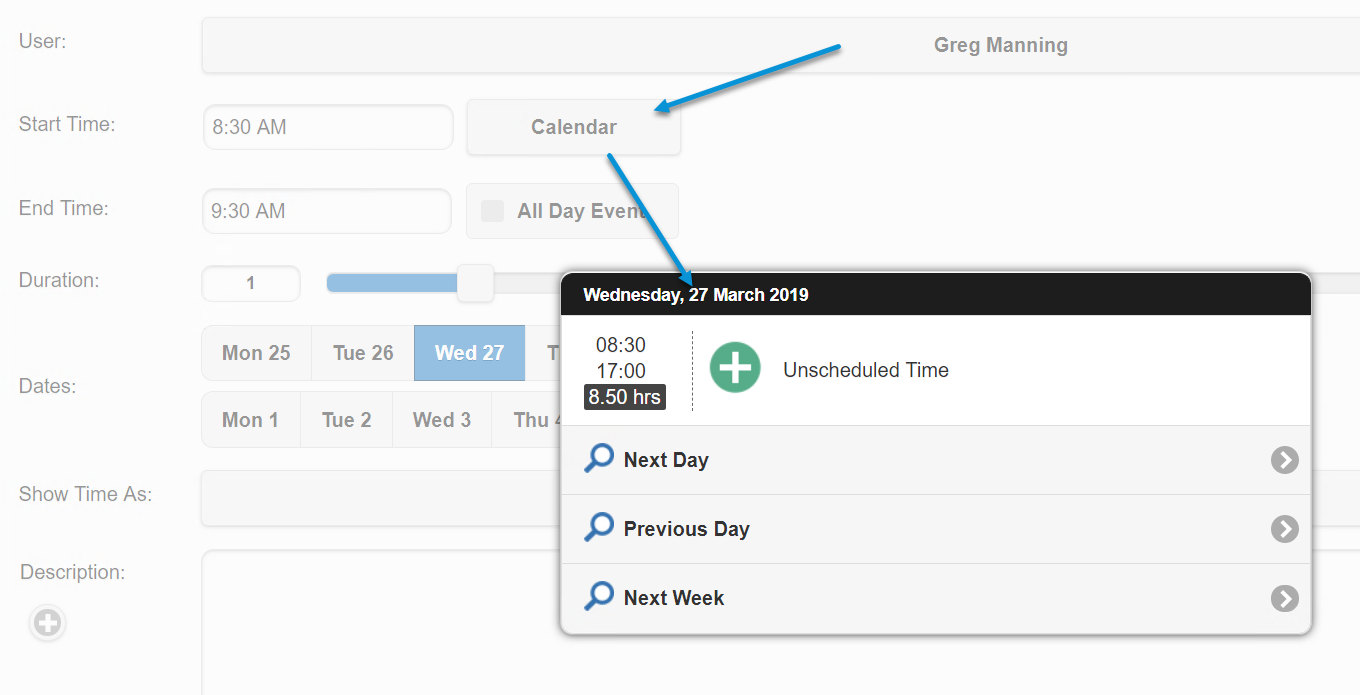
Improved Servicing Model for Serviceable Units
TimeTrak’s Serviceable Unit features have proven to be popular with our client base.
To add to these features, there is now the ability to add a service note and/or add disbursements against the serviceable unit itself.


The serviceable unit line will turn yellow when a service note has been assigned against the unit as per below.
An icon will also display against the line when a disbursement has been assigned to it also as per below:

When adding disbursements against units, the previous disbursements assigned will display with the date and user who assigned them as per below as a quick reference of previous history.

These features are designed to assist Mobile users who are servicing a lot of units in the field.
Enhanced Measurable Claiming
Another new feature which has been enhanced by client’s requests is claim measurables.
Claim measurables are quote lines against the job which are required to be “measured” so that jobs can have progress invoices generated or job managers can see how far through the job (project) they are.
There are settings and extra fields which must be enabled in the TimeTrak Administrator Console and MYOB Exo beforehand.
Once enabled, you can see claim measurables against jobs as per below:
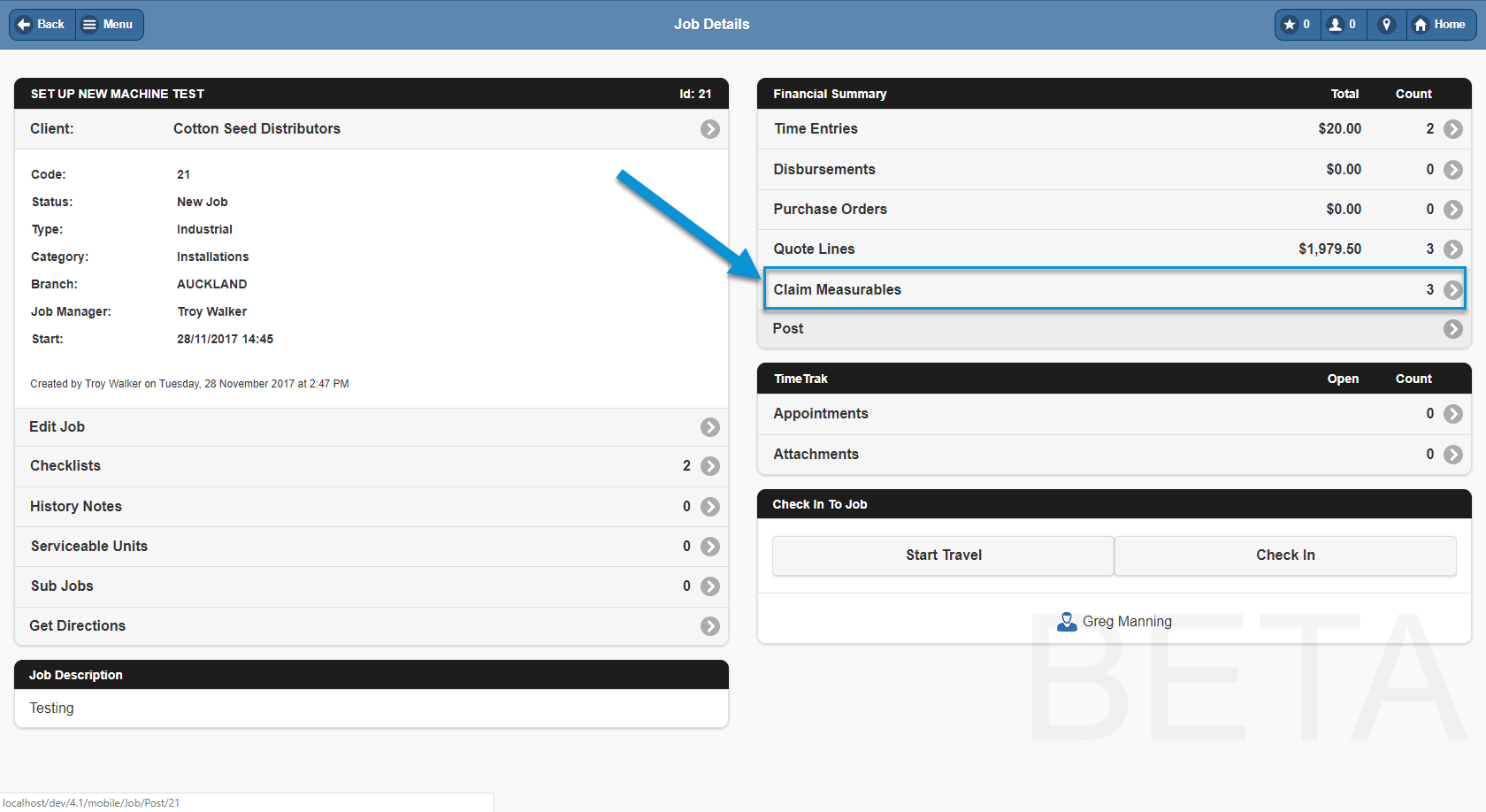
From there, you will see all the quote lines that have been created and marked as claim measurables.
There is now also the ability to display Quote Options on Claim Measurables as per below:

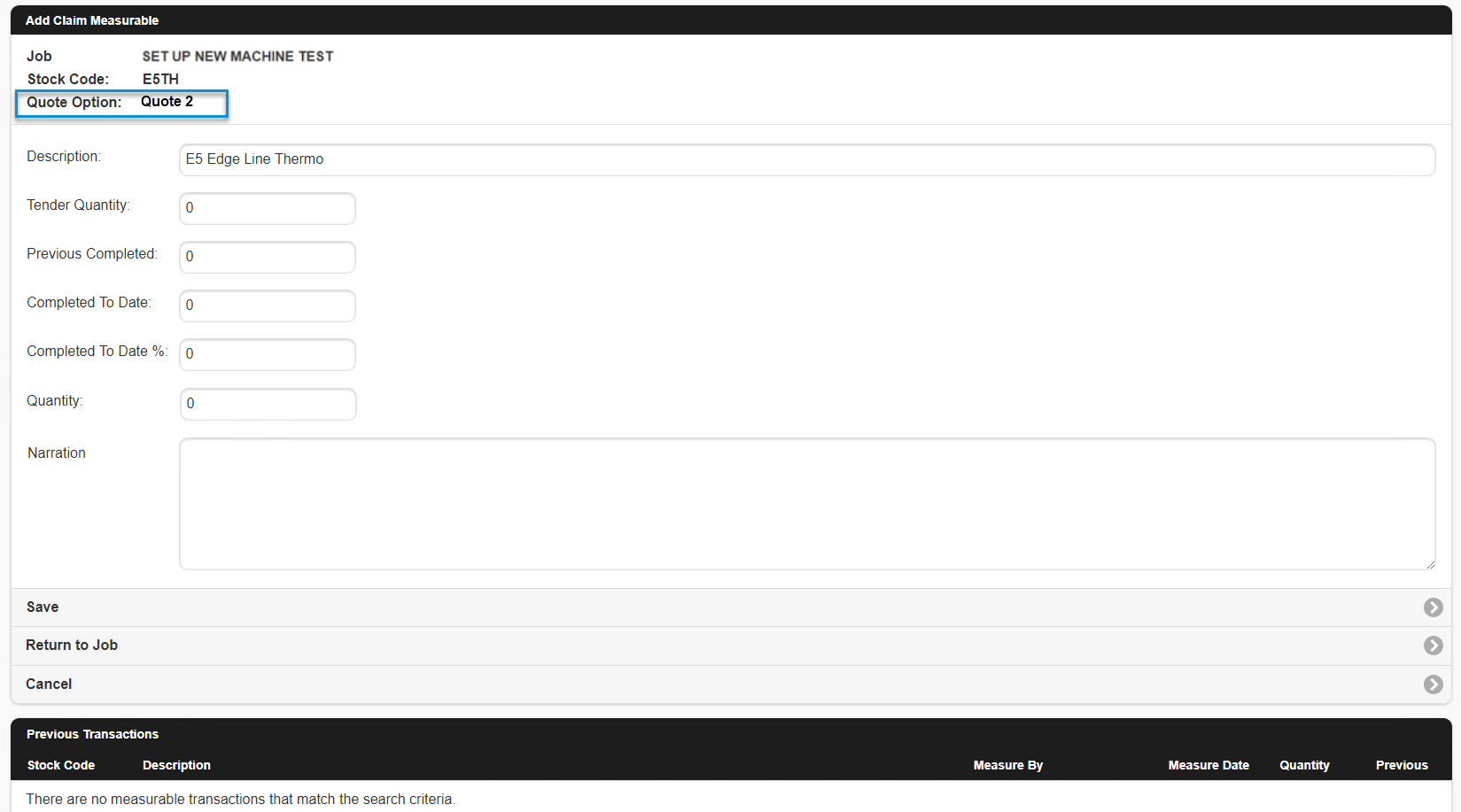
For more information on measureable claiming, click here.
Attachments with Microsoft Azure
Now, if you have Microsoft Azure, you can use the cloud service as your TimeTrak attachment storage.
Note: you can’t link the attachment to Exo if you are using Azure.
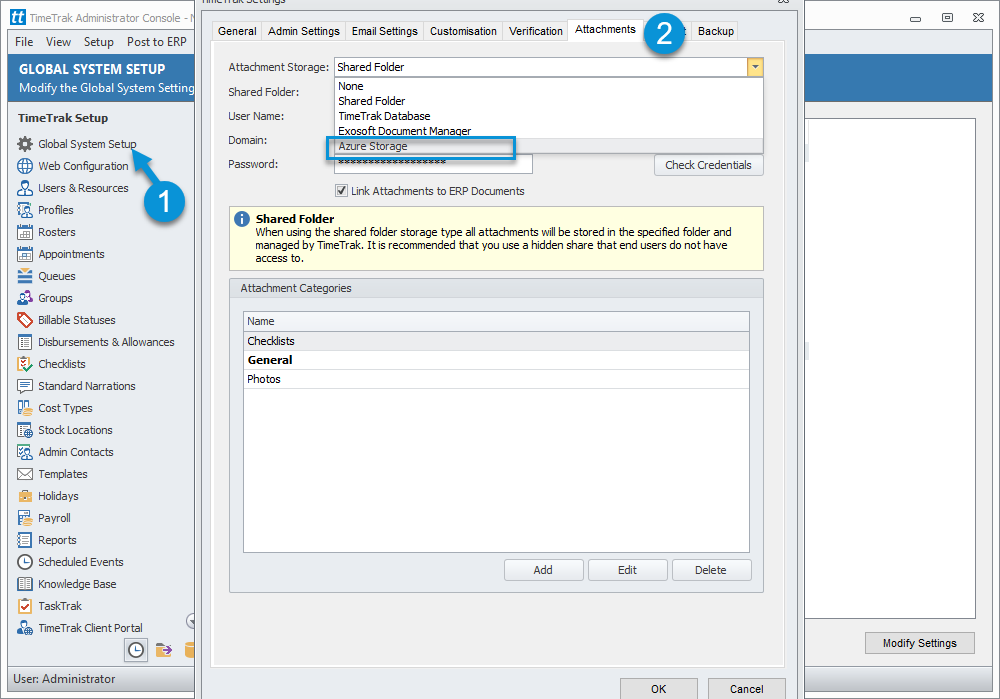
Task Enhancements
Many of our clients that use TaskTrak use Tasks as a way of further analysing their job costs.
Due to the need to further analyse these costs in TimeTrak 19.1, there is the added ability to create purchase orders, checklists and assign disbursements at a task level.
Purchase Orders against Tasks
Purchase orders can now be created at a task level in both Professional and Mobile websites.
As per below, if users have the profile settings which enable them to see and add purchase orders.

Purchase orders created against the task in TimeTrak are also available to be viewed against the job as per below.
Task Id and Task Title have also been added as columns to assist with analysing costs against tasks at the job level.

Purchase orders created against tasks still behave the same in Exo (referenced against the job)
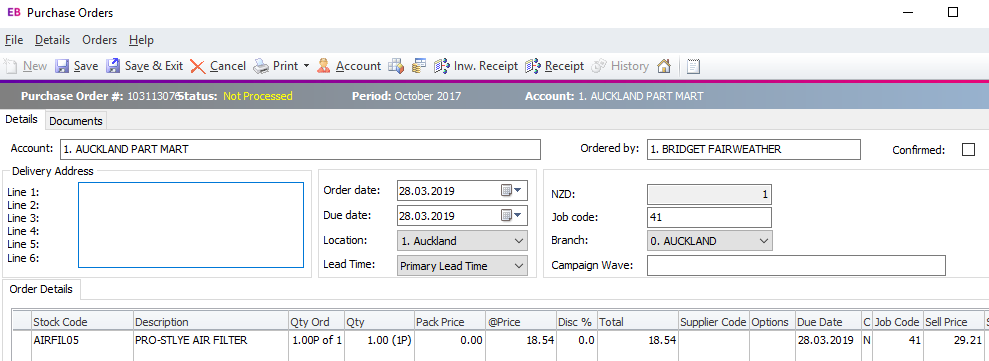
Disbursements against Tasks
Disbursements can now also be added at a Task level in TimeTrak 19.1 in both Professional and Mobile websites.
Previously clients had to assign disbursements against their time entries to provide the ability to see disbursements used at a task level which could be a time consuming process looking back through time entries to see which parts were used.
Like purchase orders, if users have the profile permissions to see and add disbursements then disbursements can be added directly against a task as per below:

Again, like purchase orders, these disbursements also flow through to the job where Task Id and Task Title columns have been added to provide the ability to quickly reference the disbursements by task.

Checklists against Tasks
Checklists are now available at a Task level in TimeTrak Mobile version 19.1.
Previously, if users were checked into a task and needed to complete a “visible” checklist (one that is manually run, not event based) the Mobile user would need to go into the job to run the checklist.
Now checklists that are visible against the users profile and meet the requirements specified at the checklist level (job type, status etc) are available to be run from the task in Mobile, as per below:
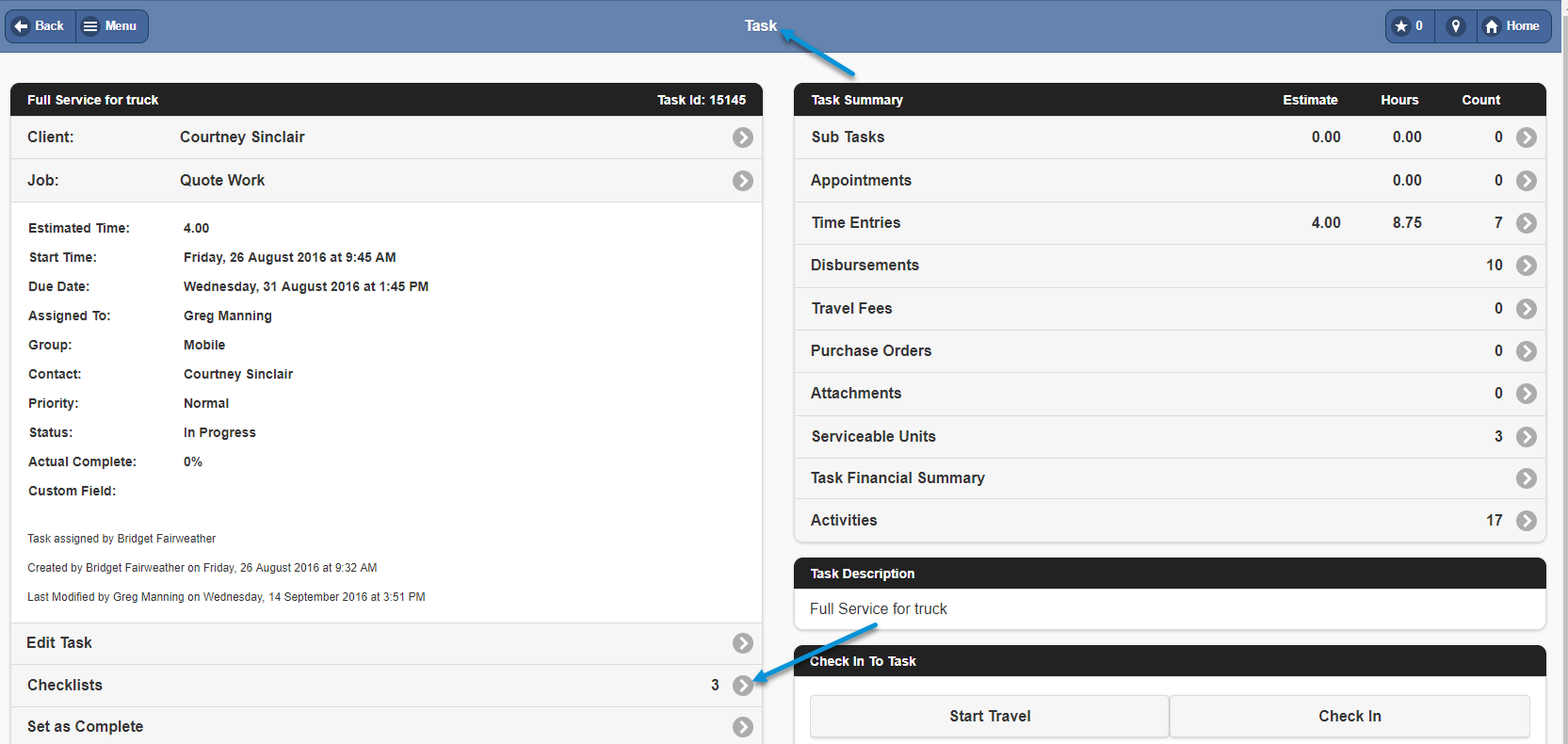
Checklists completed against the task then display in the task attachments, as per below:

Task attachments now also pull through to the job when “show task attachments” is enabled, as per below.
Again, the Task Id and Title columns have been added to provide the ability to quickly reference the attachments by task.
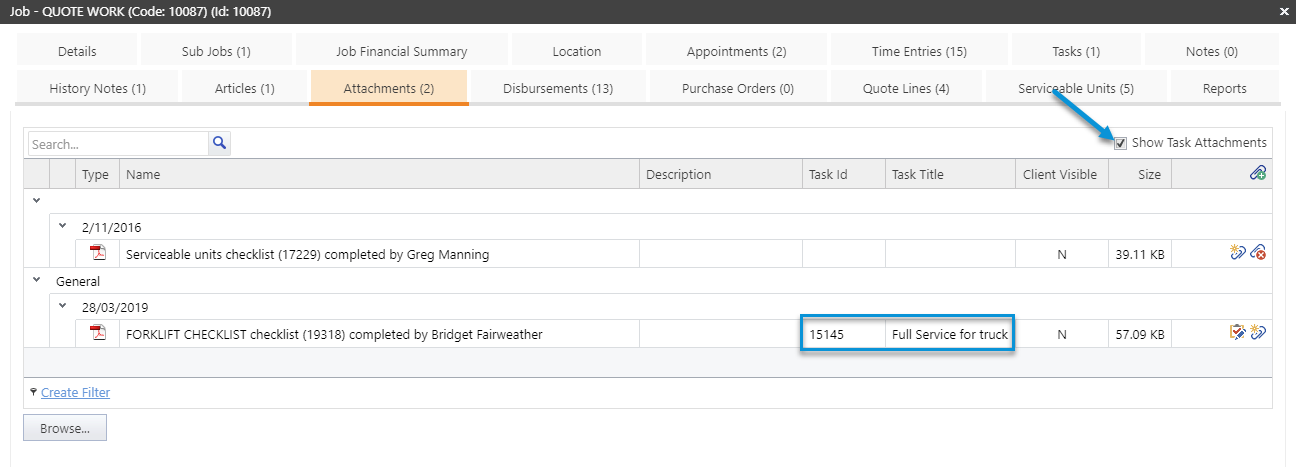
Preload Serviceable Units on Task Creation
Much like the profile setting “Preload Serviceable Units on an Appointment”, which preloads the serviceable units against the job onto the appointment on appointment creation (click here for more information).
There is now the below profile setting “Preload Serviceable Units on Task Creation” which preloads the serviceable units assigned to the job on the task on task creation.
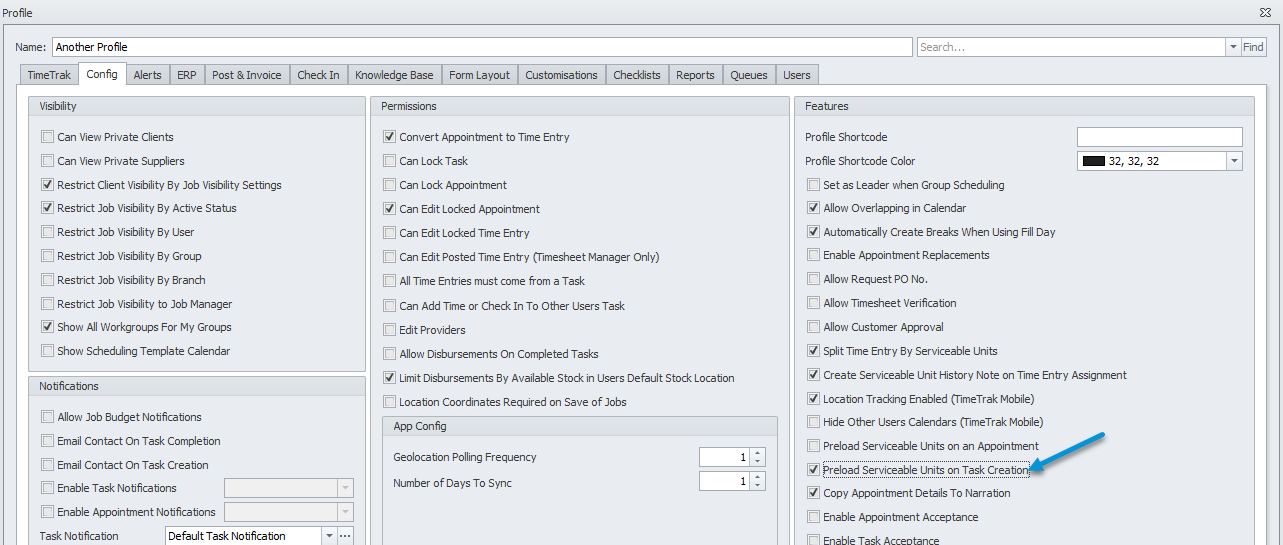
This is a useful setting for companies who are currently required to assign serviceable units to the task and they would like all the serviceable units assigned to the job to be assigned to the task by default.
Show Narration
Previously in TimeTrak, if users wanted to see the narrations of time entries or disbursements against jobs/ tasks they would need to expand the time entry one by one as per below
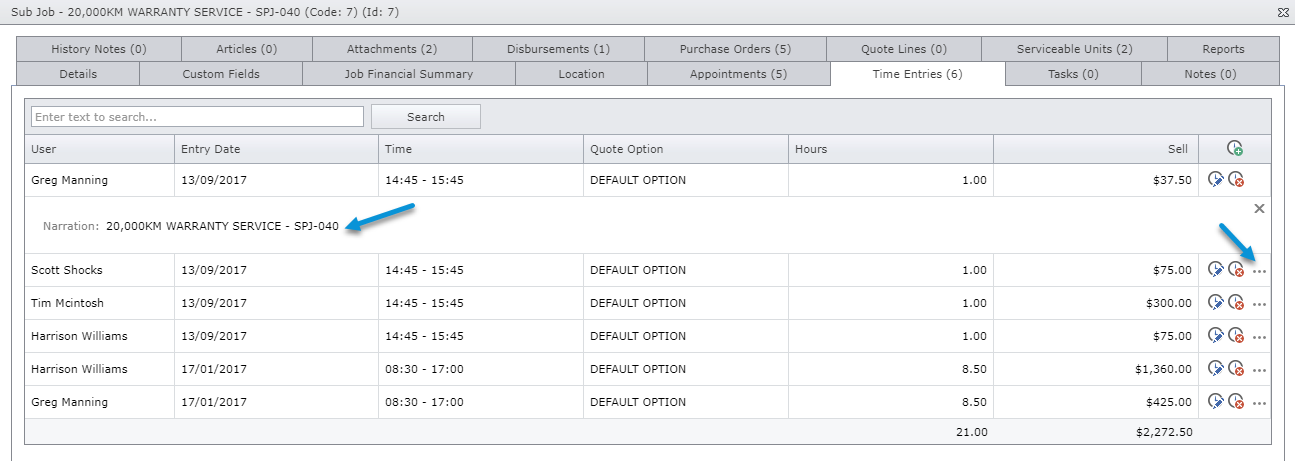
In TimeTrak 19.1 there is an added “Show Narrations” tick box which will expand the narration of all time entries and disbursements against the job/ task as per below when enabled:

Support
If you have any questions or concerns please contact a team member at Focus by either emailing support@timetrak.benandhayley.nz or for urgent support please email and then call:
- NZ – 0800 12 00 99
- Australia – 1800 60 80 77